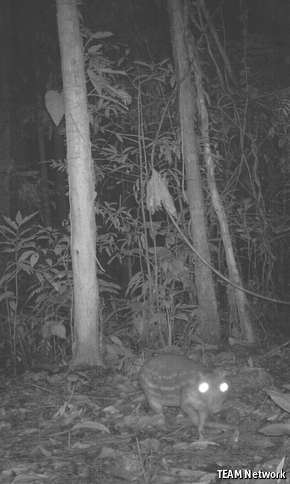SEISMOLOGISTS tend to greet the idea that some animals know when an earthquake is coming with a sizeable degree of scepticism. Though reports of odd animal behaviour before a quake date back at least as far as ancient Greece, the data are all anecdotal. They are also subject to vagaries of the human psyche: “confirmation bias” ensures that strange behaviour not followed by earthquakes gets forgotten, and “flashbulb memory” can, should an earthquake strike, imbue quotidian animal antics with great import after the fact. The US Geological Survey—arguably the world’s authority on earthquakes—undertook studies in the 1970s to find out if animals really did predict them, but came up empty-handed. However, the latest data, just published in Physics and Chemistry of the Earth, are not just anecdotal.
Friedemann Freund of San Jose State University, in California, and his colleagues considered the earthquake of magnitude seven that hit north-eastern Peru in August 2011. They found that, by coincidence, the nearby Yanachaga National Park had in the month running up to the quake been using nine so-called camera traps. These are employed to track the movements of rare or skittish animals, silently snapping pictures (for example, that above, of a paca) when motion sensors are triggered.
Well ahead of the tremor, the traps recorded up to 18 animals a day, but that number began to drop off steeply as the earthquake approached. In the five days immediately before it, the traps snapped just three animals. The park’s fauna, it seems, had stopped moving around.
Dr Freund believes that what animals sense before earthquakes is airborne electric charge. The idea is that the subterranean grinding of stressed rock which precedes a quake stores charge (not unlike that built up by scuffing shoes across a carpet), some of which then flows to the surface, where it ionises molecules in the air. The varying electric field involved in this phenomenon should be detectable from afar.
The team therefore studied data from two very-low-frequency (VLF) receiving stations in Peru, looking for perturbations of the signals. Sure enough, large disturbances occurred in the two weeks prior to the quake.
The correlation of these several facts is, of course, no guarantee of causation. Dr Freund will have his work cut out to persuade the wider world that what the VLF receiver detects is what animals are sensing, and that it is indicative of an impending quake. But he now has something concrete to work with. It may yet turn out that for millennia, furry and feathery forecasters really were trying to tell human beings something.
Scientists Find More Evidence that Animals Can Sense Earthquakes Before They Happen
Posted by Greg at 05:12, 15 Apr 2015

Skeptics on the other hand have suggested that these reports can be dismissed as examples of confirmation bias, where incidental correlations between animal behaviour and earthquakes are remembered and falsely attributed to the existing folk belief, while the many non-manifestations of such behaviour are forgotten.
A particular skeptical mantra is that ‘the plural of anecdote is not data’ – a comment on the non-evidential value of anecdotal reports. When it comes to animal behaviour before earthquakes, however, a new study has gathered actual data on the topic, and perhaps may have even contributed to substantiating the long held belief that animals can sense an earthquake coming.
The researchers took advantage of nine ‘camera traps’ being used in Yanachaga National Park in Peru to track the movements of rarely seen animals. Each time these traps’ motion sensors are triggered, they take a picture, capturing an image of the animal that is moving past the field of view.
Analysing the images over a 30 day period leading up to the 2011 magnitude 7.0 Contamana earthquake, (and comparing with a ‘control’ period not associated with an impending earthquake), they found that the camera traps usually ‘captured’ up to 18 animals a day. However, this number dropped off to much lower numbers consistently around 23 days before the earthquake, and then reduced further just over a week from it striking. In fact, only three animals in total were photographed in the last six days before the earthquake struck, with rodents – the most abundant animal in the forest environment – almost completely disappearing.

- Emission of ultra-low frequency (ULF) electromagnetic waves that may affect biochemical reactions and disrupt circadian rhythms.
- Oxidisation of soil organics, creating toxic and/or irritating trace gases, such as carbon monoxide.
- Ionisation of air molecules – which has been reported to cause blood serotonin levels to increase in animals and humans.
The researchers concluded:
An enhanced air ionisation at the ridge prior to the magnitude 7 Contamana earthquake may have caused the animals to escape to lower altitudes, where they would have been exposed to fewer positive airborne ions. The pre-earthquake anxiety, restlessness and escape reactions of domestic or captive animals, reported anecdotally for many decades, even centuries, may simply be due to the fact that confined animals tend to panic when they are unable to move away from aversive stimuli in their environment. If this correlation can be substantiated by systematically monitoring a wider range of reported pre-earthquake phenomena, this would lead to a better understanding of the premonitory abilities of animals.
Source: “Changes in Animal Activity Prior to a Major (M=7) Earthquake in the Peruvian Andes”

